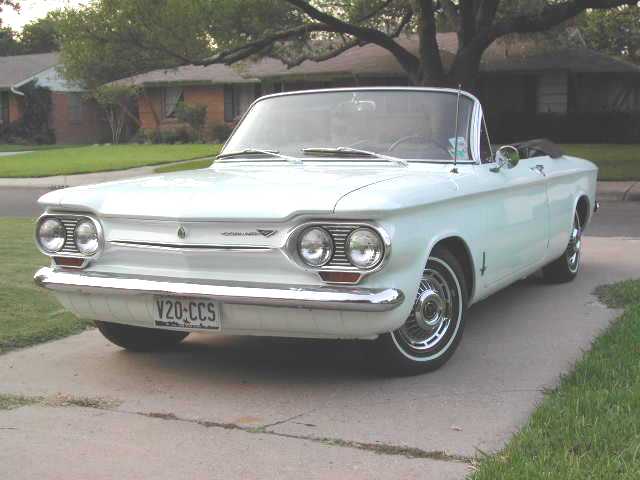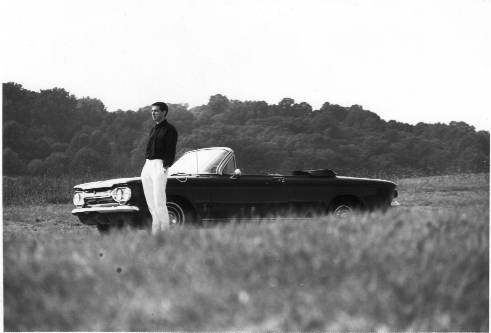March 01, 2008

More than a few acquaintances have told me how much they'd like to have an old car to drive, work on, and just enjoy.
I drove the vintage convertible above every day for 16 years, and I have some enlightenment to offer.
It's neither all good nor all bad, but an admixture of experiences in no particular order.
Some of the great moments included when:
- I was asked to lead a parade.
- A hotel valet parked my car right out front.
- A co-worker told me I made him laugh that morning when I passed him with the top down, singing.
- On a dark, snaky rural road, the headlights failed, and the only way to restore them was to step on the dimmer switch, which meant the lights went off with every gearshift.
- This picture was taken:
- I built an air-conditioning system and installed it. And it worked.
- Patrons at a happy hour stood helplessly watching as their new cars outside got hammered by hailstones, which either bounced off my top or disintegrated on the heavy-gauge body.
- Over several weeks I took the engine apart piece-by-piece, and upon reassembly, started it on the first try.With vintage cars, "dependable" means "it breaks with advance warning in ways that you can fix."
- The defroster only added to the condensation, requiring me to stop several times on a cold night to clear the view. This endeared me to my date, which demonstrates once again that cars are more easily understood than girls.
- The ignition coil failed at a gas station in rural Tennessee, where a stranger, traveling with his family, offered to drive me to a parts store.
- After replacing the clutch disc, I mated the engine and transaxle on the garage floor, which is like mating a pair of particularly uncooperative, quadriplegic horses covered with oil.
- I learned to strip paint with a baking-soda blaster, which is like firefighting but much more messy.
- The body shop finished the restoration and I drove home in a gleaming, new classic.
The not-so-great moments:
- The collision six months after the restoration.
- Spending several weeks and more than $200 on parts to troubleshoot a charging problem, which turned out to be a rotten wire at the ignition switch.
- The second top replacement.
- The third clutch job.
- An annoying vibration which continued until I found its source in an "improved" part I had added several years earlier.
- Somebody made off with my shift knob.
- Ignition failure, on the way to work.
- Rain dribbling in above the windshield, increasing with speed.
- The purchaser told me he had put the car in storage.
In the 10th year I owned the car, a fellow at my company asked if I would look at a similar model he wanted to purchase. On the way to view it, I quizzed him on his mechanical experience. He had none, but he thought he could find someone to maintain the car for him. He asked if I was interested in the job. I said, No, I couldn't be responsible for the reliability of someone else's car.
We drove the vehicle a few miles and returned it. Although it felt sturdy to me, I suggested he locate a mechanic knowledgeable in old cars, or be willing to learn patiently and invest in some tools. He thanked me and, a few days later, bought the car.
The next week he called to ask if I knew where to get a battery. And how to install it.
The car sat in the office parking lot until he sold it a month later.
to most people, "dependable" means you turn the key and go. With vintage cars, "dependable" means "it breaks with advance warning in ways that you can fix."
To have a healthy relationship with your classic, you cannot ignore a leak, or a noise, or a funny smell, or a drop in performance; these portend a breakdown. All moving parts eventually need repair or replacement, and most of them give warning signs, with the exception of electrical stuff, and in my case the cam gear, which expired one winter day on IH-35E, bequeathing just enough momentum to usher me down an exit ramp to a parking lot. Remedy: full engine rebuild.
Which leads to my second point: I would not keep a vintage car unless I drove it every day. Absent that need, I would rarely devote the time to fix it.
Of course, if you are retired or otherwise free from the commitments of career, family, etc., then an old car can be a joy to maintain. You'll have the time to upgrade some of the outmoded systems (e.g., ignition) and to study others' techniques for improving reliability.
Toward that end, the Internet alleviates much of the frustration in keeping a vintage car, because you can quickly tap the experiences of others in times of trouble. My marque even had an e-mail list that spat out daily conversations among owners on the myriad improvisations that keep a 40+ year-old car running. As well, over the Web, the parts vendors can reach their small customer base inexpensively.
Before that, it was Hemmings Motor News and your local club, and if you didn't live in a city large enough to support a club, you were on your own.
finally, never think of an old car as an investment. The only people who claim to make money in old cars are experts who know exactly which models to buy and sell at the right time. They have others maintain their collections. I doubt they actually operate at a profit, based on the number of dealers I've seen come and go. If the professionals can't even make a dollar at it, odds are that amateurs can't, either.
That said, because I drove my classic as I would any other car, it could be thought of as a good investment transportation-wise because I made no payments and it cost little to insure. I spent plenty on parts, but nothing like the cost of a new car. When I sold it, the price about equaled the purchase price in constant dollars. You cannot say that for any car bought new.
Posted by: Michael Rittenhouse at
05:40 PM
| Comments (1)
| Add Comment
Post contains 1034 words, total size 7 kb.
I was relieved to finally sell the thing. But, on the days that it was working, boy did I look cool.
Posted by: Seppo at May 08, 2008 04:59 PM (ExDt+)
23 queries taking 0.0136 seconds, 18 records returned.
Powered by Minx 1.1.6c-pink.

